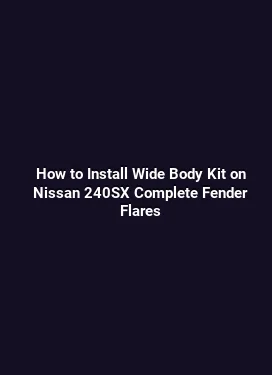Best Bumper Vents for Brake Cooling and Aerodynamic Benefits
In modern performance vehicles, the integration of bumper vents is more than a cosmetic upgrade. Properly designed vents play a crucial role in brake cooling, engine bay temperature management, and the overall aerodynamic profile of a car. This article dives into the anatomy of effective bumper vents, how they influence cooling and drag, and practical steps to choose, install, and maintain vents that deliver real-world benefits. Readers will find detailed explanations of airflow principles, materials, installation considerations, and performance-tested configurations that go beyond surface-level descriptions.
Vehicle Cooling and Aerodynamics: The Interaction of Airflow with the Front End

Air entering the front of a vehicle encounters a complex flow regime. The goal of bumper vents is to intercept high-energy boundary layers and channel cooler air toward critical components such as brake discs, calipers, and intercoolers, while minimizing induced drag. Effective venting reduces heat soak in braking systems, preserving pad and rotor performance during spirited driving or track use. Simultaneously, vents influence the pressure distribution around the bumper and wheel arches, shaping vortices and contributing to a smoother, more laminar flow along the underbody and side surfaces.
Designers balance two competing demands: maximizing cooling airflow and lowering aerodynamic drag. Poorly placed or oversized vents can create unwanted turbulence, increasing drag or altering steering feel at high speeds. The best bumper vent solutions use precise geometry, complementary ducts, and, where possible, integration with underbody treatments like splitters or side skirts to guide air efficiently. This balance between cooling and drag reduction is a central theme in choosing the right vent configuration for a given vehicle and usage scenario.
Key Design Elements of Effective Bumper Vents
The effectiveness of bumper vents hinges on several interrelated elements. Understanding these helps enthusiasts select vents that deliver measurable improvements rather than cosmetic changes. The major design considerations include vent geometry, ducting, ingress and egress paths for air, and compatibility with existing body lines and mounting points.
Vent Geometry: Size, Shape, and Edge Treatment

The cross-sectional area of a vent determines the volume of air that can pass through at a given pressure difference. Too small a vent restricts airflow to brakes, causing higher temperatures and potential brake fade. Too large a vent can disrupt the vehicle’s front-end pressure field and increase drag. The optimal geometry often includes a honeycomb or mesh insert to smooth incoming air and reduce noise while maintaining clear pathways for exhaust or brake-sphere air. Edge treatment, such as radiused lips or polished transitions, minimizes flow separation at the vent mouth, which translates to cleaner, more predictable behavior at high speeds.
When evaluating vent shapes, performance-focused builders look for profiles that mirror the vehicle’s frontal curvature. Circular, oval, or rectangular openings can be used depending on the mounting location and duct routing. In many applications, angled or slanted vent faces encourage air to follow the undercarriage corridor rather than creating large, stationary turbulent zones near the bumper interface.
Ducting and Air Pathways: Directing Air to Critical Components
Vent effectiveness often hinges on the downstream ducting that carries air from the bumper into caliper regions, rotor spaces, or intercooler cores. Short, well-sealed ducts reduce pressure losses and prevent recirculation. Flexible hoses, rigid channels, or a combination of both can be employed. The use of shrouds or collars at the vent inlet can channel air through a dedicated path, while avoiding interference with the wheel well liner or suspension components. Ducting should also minimize heat exchange with engine bay contents to ensure the air remains cool as it reaches the brakes or intercoolers.
In addition, the integration with an undertray or front splitter can encourage a more coherent flow. When air exits the vent into a channel that leads toward the rotor area, it helps create a low-pressure region around the braking components, promoting faster heat removal. The design goal is to reduce boundary layer thickness and maintain an organized flow that travels in a predictable direction rather than creating random eddies that degrade performance.
Material Choices and Finish: Balancing Weight, Durability, and Aesthetics
Vent components range from high-strength plastics and composites to metal alloys, each offering different trade-offs. Plastic vents are lightweight and inexpensive but must resist high-temperature exposure and UV degradation. Composite materials provide stiffness and heat resistance with a favorable strength-to-weight ratio. Metals, while heavier, can offer superior durability for track use and aggressive road conditions. Finishes should resist corrosion and be able to withstand road debris without compromising the vent’s performance. For enthusiasts seeking a high-end appearance, machined aluminum or carbon fiber accents can offer both functional cooling benefits and an elevated aesthetic.
Maintenance considerations include cleaning channels to prevent clogging by debris, inspecting seals for integrity to avoid air leaks, and periodically checking for cracks or warping after pothole-heavy driving. Proper mounting hardware—stainless steel or corrosion-resistant alloys—helps maintain vent alignment and eliminates wobble that could degrade airflow over time.
Practical Installation Considerations: Fitment, Sealing, and Alignment
Proper installation is essential to realize the theoretical cooling and aerodynamic benefits. A successful install respects the vehicle’s original geometry, avoids interfering with suspension or steering components, and ensures sealing against the external environment. Vans, sedans, sports cars, and hatchbacks all present unique challenges, but the core principles remain consistent: clean mounting, airtight seals, and verified airflow paths.
Before drilling or permanent modifications, it is advisable to perform a dry fit and assess airflow behavior in a controlled environment, such as a wind tunnel or CFD analysis if available. If permanent mounting is required, use manufacturer-recommended fasteners and adhere to torque specifications to prevent warping or damage during high-load events. Seals should be chosen to resist vibration and heat to minimize flutter and air leaks, particularly at highway speeds where wind pressures are substantial.
For vehicles with complex bumper geometries or integrated fog light housings, it may be beneficial to work with a professional installer who understands how venting interacts with the vehicle’s front-end structure. In some cases, a retrofit package includes a custom ducting harness and a compatible undertray that complements the OEM aero profile while delivering improved cooling performance.
Testing and Verification: How to Assess Real-World Benefits
Empirical testing is essential to validate the expected gains. Torque-based drag measurements, brake temperature monitoring, and real-time thermal imaging are common methods used by enthusiasts and professionals. Environmental testing under different loads and at various speeds helps quantify the impact of venting on brake fade resistance and overall drag reduction. A systematic approach may include baseline measurements without vents, followed by controlled installation of a chosen vent system, and then repeated tests to compare data sets.
CFD simulations and wind tunnel data can provide early insights into expected performance, identifying potential hotspots or flow separations before physical installation. While not always accessible to casual hobbyists, these tools offer a powerful way to optimize vent placement and duct routing. When real-world testing confirms durability and effectiveness, the combination of improved brake cooling and refined aerodynamic behavior becomes a compelling upgrade for performance vehicles.
Maintenance, Durability, and Longevity of Bumper Vents
Durability is a primary consideration, especially for daily drivers exposed to road debris and weathering. Regular inspection for cracks, warping, or loose fasteners protects the integrity of the cooling path. Debris accumulation at vent inlets can impair airflow and reduce cooling efficiency, so periodic cleaning is recommended. Sealant integrity should be checked to ensure there are no air leaks that would degrade performance. UV-resistant finishes extend the life of exterior vents, while corrosion-resistant hardware reduces maintenance costs over time.
Beyond exterior care, it is important to monitor the surrounding bumper area for signs of heat-related stress. In high-demand scenarios, such as track days, some drivers select vents with reinforced supports or secondary cooling channels to maintain performance under repeated braking cycles. A thoughtful combination of vent sizing, duct routing, and protective shields can significantly extend the effective life of both the venting system and the braking components it serves.
Trends and Semantics: How Modern Venting Aligns with Performance Language
Current trends emphasize the synergy between cooling performance and drag reduction, driven by data-backed testing and real-world needs. Design language often highlights airflow management, thermal efficiency, and system integration. In parallel, the use of high-performance materials and advanced manufacturing techniques supports lighter, stronger vent assemblies. Semantically, discussions around venting frequently touch on concepts like boundary layer control, flow separation minimization, and streamlined front-end architecture, underscoring the technical nature of modern bumper vent choices without resorting to jargon that detracts from practical stewardship of vehicle performance.
For enthusiasts, the practical takeaway is to choose vent solutions that demonstrably improve brake temperatures and reduce drag without compromising structural integrity or visual appeal. Whether installing a set of factory-inspired vents or an aftermarket system, the emphasis remains on credible performance gains, supported by testing and real-world experience rather than solely on aesthetics or marketing claims.
Real-World Scenarios: Selecting the Right Bumper Vent for Your Vehicle
Not all cars benefit equally from bumper vents. A modern sports sedan with a well-designed cooling system may gain modest improvements, while a high-downforce race-bred package can see meaningful reductions in brake temperatures and improved lap times. Key decision criteria include the vehicle’s brake setup (disc size, caliper material, and rotor ventilation strategy), the presence of other aero components (splitters, canards, undertrays), and typical driving conditions (daily commuting vs. track days).
In practice, the best bumper vent solution offers a balanced approach: adequate inlet area to support brake cooling, a duct path that minimizes pressure losses, and a robust mounting system to withstand high-speed airflow and road conditions. For road-going cars, a vent kit that integrates smoothly with the bumper geometry and undertray tends to deliver the most consistent benefits. For track-focused builds, a more aggressive venting and ducting strategy, combined with careful thermal management of the brake system, yields the strongest performance gains.
Finally, the decision should consider maintenance and compatibility. Installations that are easy to service, with replaceable seals and modular ducts, will have a longer useful life and lower total cost of ownership. A comprehensive approach that includes testing, fitment checks, and periodic maintenance will maximize the longevity and effectiveness of bumper vents in any performance-oriented vehicle.
What to Look for When Shopping for Bumper Vents
Shoppers should evaluate vent kits on several fronts: compatibility with their vehicle’s bumper design, the quality and aerodynamics of the vent shape, the ease of installation, and the reliability of the ducting system. A credible kit provides precise fitment instructions, high-quality hardware, and clear sealing solutions to prevent air leaks. It should also offer documentation on tested cooling improvements and drag characteristics, even if the exact numbers vary by vehicle and driving conditions.
For those who value aesthetics as well as function, consider whether the vent integrates with existing styling cues or adds a contrasting accent. Ceramic-coated or carbon-fiber details can provide a sportier appearance while maintaining performance benefits. It is also wise to review customer feedback and installation tips from similar vehicle models to anticipate potential challenges and optimal mounting strategies.
Conclusion for the Informed Enthusiast
Choosing the right bumper vents requires a careful balance of cooling efficacy, aerodynamic impact, and practical integration with the vehicle’s front-end architecture. By focusing on vent geometry, controlled ducting, durable materials, and rigorous testing, drivers can unlock meaningful gains in brake performance and overall efficiency. The most compelling solutions are those that align with real-world usage, supported by data and a thoughtful approach to installation and maintenance. As performance engineering evolves, bumper vents remain a practical, data-informed option for enhancing both cooling and aerodynamics on a wide range of vehicles.






